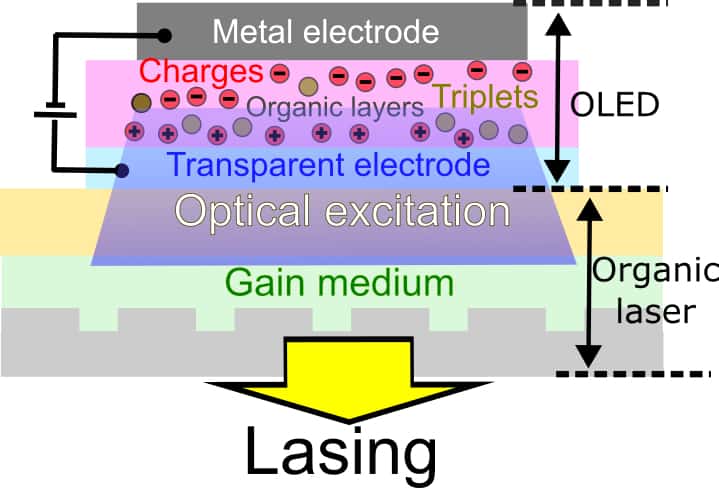
Researchers at St Andrews University in Scotland have made the first organic semiconductor laser that does not require a separate light source to operate – something that had proved extremely challenging. The new all-electrically-driven laser is more compact than previous devices and operates in the visible region of the electromagnetic spectrum. As such, its developers say it might find use in applications such as sensing and spectroscopy.
Lasers work by bouncing light back and forth many times in an optical cavity comprising a gain medium sandwiched between two mirrors. As the light reflects back and forth between the mirrors, the gain medium amplifies it, stimulating the emission of more light and creating a coherent beam with a very narrow spectral range.
The first organic laser – that is, one made from a carbon-based material – was created in 1992. That laser, however, used a separate light source to drive its gain medium, which complicated its design and limited its applications. Ever since, researchers have tried to find a way to make an organic laser that works using only an electrical field to drive it, but without success. “This has therefore been a grand challenge in the field for the last 30 years,” explains physicist Ifor Samuel, who co-led the new study with his St Andrews colleague Graham Turnbull.
First, break a world record
There are two main strategies for designing an electrically-driven organic laser, Samuel explains. The first is to place electrical contacts on the organic laser gain medium and inject charges through them. It is difficult to make a laser in this way, however, because the injected charges absorb light across the luminescence spectrum of the material via so-called triplet states. The contacts themselves also absorb light. “Since a laser needs gain (optical amplification) to exceed losses, this light absorption is a huge barrier,” says Samuel.
In the new work, which is detailed in Nature, the researchers tackled this problem in the second way: by spatially distancing the charges, triplets and contacts from the laser gain medium. Doing this was no easy task either, however, as it meant they needed to make a pulsed blue organic light-emitting diode (OLED) with world-record light-output intensity to drive the gain medium. They then needed to figure out a way to couple all of this OLED’s light into the laser, which they made from a thin layer of semiconductor polymer that emits green light.
“To make the device, we initially fabricated the OLED and laser cavity separately before transferring the OLED, on a substrate of only a few microns thickness, onto the surface of the laser waveguide,” he says. “Careful integration of the two sections was crucial for the gain medium to access the intense electroluminescence generated internally in the OLED.”
To complete the design, the team used a diffraction grating in the thin-film laser to provide a distributed feedback of stimulated light emission in the plane of the film, while diffracting an output laser beam from the surface.
A slow technology speeds up
Organic semiconductor devices are widely thought of as a “slow” technology because the charge mobility in organic materials is typically orders of magnitude lower than it is for silicon or III-V crystalline semiconductors. Turnbull, however, thinks the team’s innovations could start to change that perception. “Our work is pushing these materials into a very fast and intense operating scheme,” he tells Physics World.

New semiconductor laser delivers high power at a single frequency
As for applications, the researchers say the new all-electric organic semiconductor lasers would be straightforward to integrate into point-of-care medical devices that use light-based sensing and spectroscopy to diagnose illness or monitor symptoms. “Electrical driving removes the need for a separate light source to pump them, which should widen potential applications,” Turnbull says.
There is further work to do, however, to optimize the new laser’s output power and efficiency and to broaden its light output across the visible spectrum. “The next big challenge in the field will be to make continuous-wave organic semiconductor lasers, which will need further control of the troublesome triplet population,” Turnbull concludes.
- SEO Powered Content & PR Distribution. Get Amplified Today.
- PlatoData.Network Vertical Generative Ai. Empower Yourself. Access Here.
- PlatoAiStream. Web3 Intelligence. Knowledge Amplified. Access Here.
- PlatoESG. Carbon, CleanTech, Energy, Environment, Solar, Waste Management. Access Here.
- PlatoHealth. Biotech and Clinical Trials Intelligence. Access Here.
- Source: https://physicsworld.com/a/all-electric-organic-laser-is-a-first/
- :has
- :is
- :not
- 160
- 30
- a
- AC
- access
- across
- All
- also
- Amplification
- amplifies
- an
- and
- andrews
- applications
- applied
- applies
- ARE
- AS
- At
- back
- barrier
- BE
- Beam
- because
- been
- before
- between
- Big
- Blue
- Break
- broaden
- but
- by
- challenge
- challenging
- change
- charge
- charges
- click
- COHERENT
- colleague
- compact
- complete
- complicated
- comprising
- concludes
- contacts
- contains
- control
- could
- Couple
- created
- Creating
- crucial
- delivers
- Design
- designing
- detailed
- developers
- device
- Devices
- difficult
- distributed
- do
- does
- doing
- drive
- driving
- easy
- efficiency
- either
- emission
- EVER
- exceed
- excites
- Explains
- extremely
- FAST
- feedback
- few
- field
- Figure
- Film
- Find
- First
- For
- forth
- from
- further
- Gain
- generated
- generating
- grand
- Green
- green light
- had
- Half
- Have
- he
- High
- his
- However
- http
- HTTPS
- huge
- illness
- image
- in
- information
- initially
- inject
- innovations
- integrate
- integration
- internally
- into
- issue
- IT
- ITS
- jpg
- laser
- lasers
- Last
- layer
- layers
- Led
- light
- Limited
- losses
- lower
- made
- Main
- make
- many
- material
- materials
- max-width
- meant
- medical
- medium
- might
- mobility
- Monitor
- more
- narrow
- Need
- needed
- needs
- New
- next
- no
- of
- on
- ONE
- only
- onto
- open
- operate
- operates
- operating
- Optimize
- or
- orders
- organic
- out
- output
- perception
- Physics
- Physics World
- Place
- plane
- plato
- Plato Data Intelligence
- PlatoData
- population
- potential
- power
- previous
- Problem
- proved
- provide
- pump
- Pushing
- range
- reflects
- region
- require
- researchers
- say
- says
- scheme
- Second
- sections
- semiconductor
- Semiconductors
- separate
- should
- Silicon
- since
- single
- slow
- some
- something
- Source
- Spectral
- Spectroscopy
- Spectrum
- speeds
- start
- States
- straightforward
- strategies
- structure
- Study
- success
- such
- Surface
- Symptoms
- Task
- team
- Technology
- tells
- than
- that
- The
- Them
- themselves
- then
- therefore
- These
- they
- Thinks
- this
- thought
- Through
- thumbnail
- times
- to
- top
- Transferring
- tried
- true
- two
- typically
- Uk
- university
- use
- used
- using
- very
- via
- visible
- Voltage
- was
- Way..
- we
- which
- while
- WHO
- widely
- widen
- will
- with
- without
- Work
- works
- world
- would
- years
- zephyrnet













